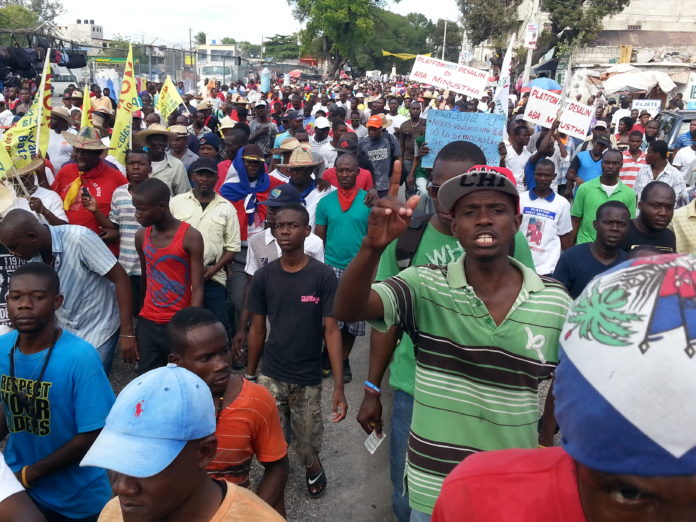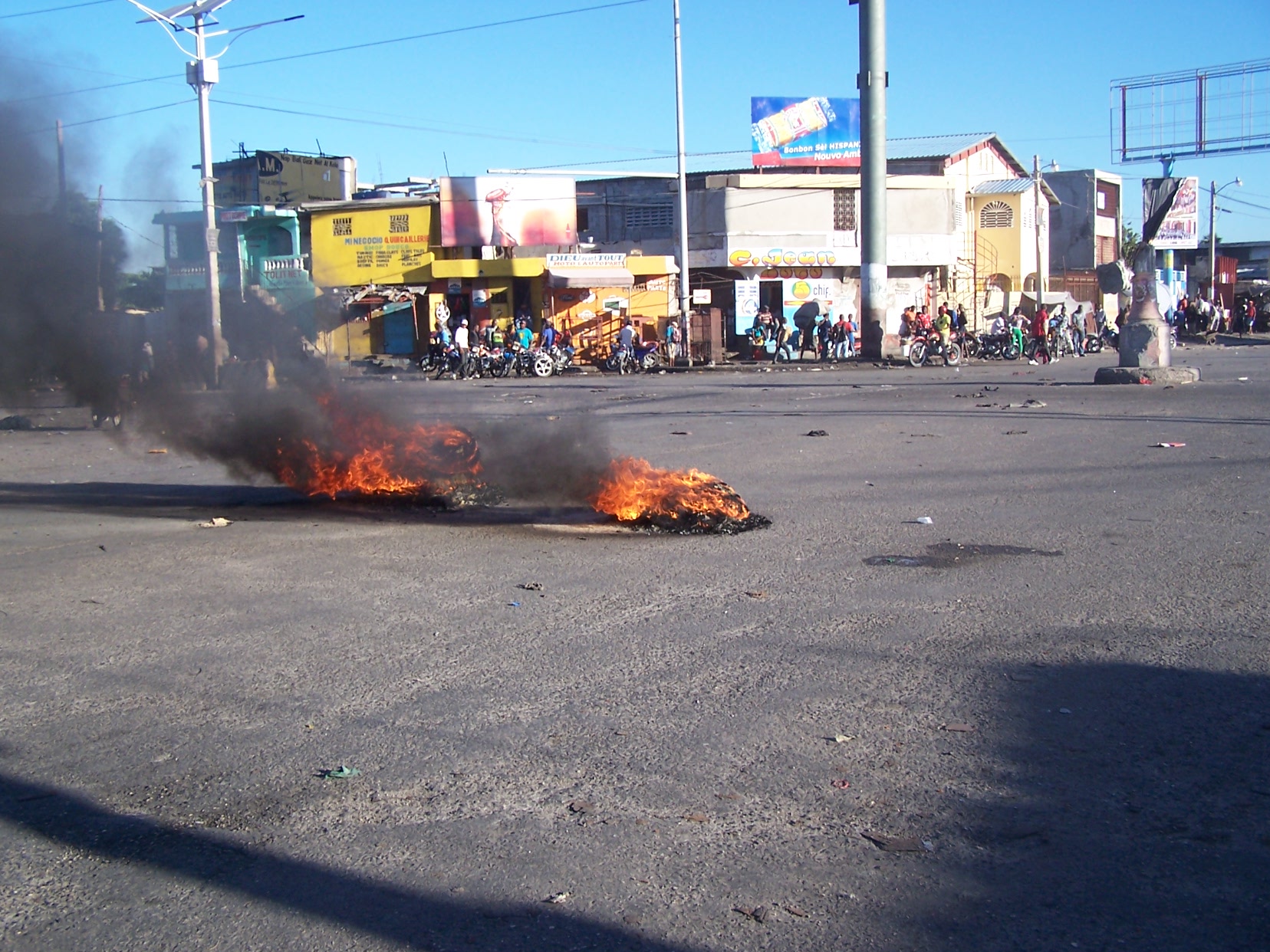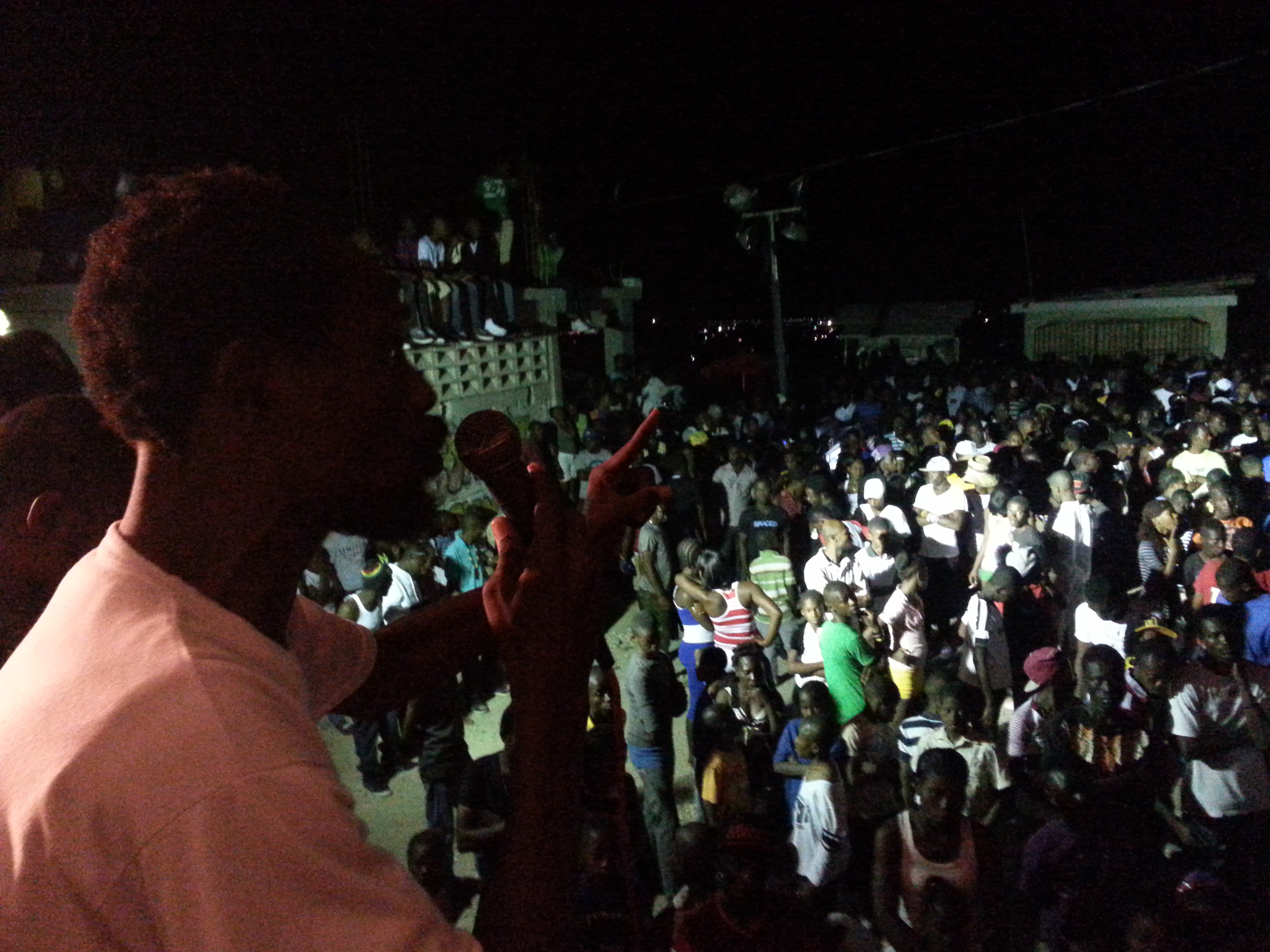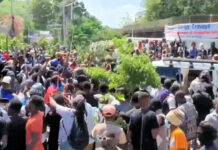
Port-au-Prince’s hilltop slum of Fort National offers a perfect example of the irony, agony, and struggle that grip Haiti today.
Its rocky moonscape is littered with piles of dirt, debris, and garbage. Untold hundreds of residents died here when the Jan. 12, 2010 earthquake destroyed eight out of ten of the closely-packed cinderblock and tin shacks which crowded – and today again crowd – dark narrow corridors down which sewage runs. Flies and rats cohabit this grim warren with large families whose children in doorways (often barricaded by no more than a curtain) squat like frogs, leaping away when a stranger passes.
Looking out across Fort National’s patchwork of tin rooftops, tendrils of twisted rusting iron rebar reach out of unfinished cinderblock walls, like fingers beseeching the heavens for manna.
Looking out across Fort National’s patchwork of tin rooftops, tendrils of twisted rusting iron rebar reach out of unfinished cinderblock walls, like fingers beseeching the heavens for manna.
At the top of this neighborhood perched on top of the capital’s highest downtown hill is a giant billboard that once showed an architect’s vision of a leafy flowered apartment complex with wide walkways and well-dressed people. This construction project, to be carried out by a Dominican construction firm under a contested no-bid contract, was to be funded with $174 million of the more than $13 billion in international aid pledged to Haiti after the earthquake. The sign, along with its promise, has long since faded, like so many projects trumpeted in Haiti after the earthquake. Less than half of the $13 billion has ever been dispersed, and beyond a few luxury hotels and a giant assembly park in the north, far from the earthquake area, it is hard to see much change in Haiti’s harsh realities after the world’s outpouring of support.
Where did Fort National’s $174 million go?
“We were told by Martelly’s officials that about $44 million of it supposedly went to build about 3000 small homes out in the remote desert by Morne à Cabri,” said former Sen. Moïse Jean-Charles. “But when I asked Martelly’s Finance Minister in a Senate hearing where the rest of the money went, he just smiled. At least, I thought, that was honest.”

The Fort National neighborhood is also home to Fort National, a fortress built by Haiti’s founding father Gen. Jean-Jacques Dessalines to guard against feared French, English, or Spanish reprisals or recolonization attempts after Haiti’s Jan. 1, 1804 independence proclamation, the first in Latin America.
However, today, this garrison built to repel foreign invaders is occupied by them: troops of the hated United Nations Mission to Stabilize Haiti or MINUSTAH. Deployed in Haiti since Jun. 1, 2004, the Brazilian-led force, now about 7,500, has been responsible for massacres, rapes, sexual abuse, and, most notoriously, the import of cholera in October 2010. Outhouses leaking Nepalese UN soldiers’ feces infected Haiti’s largest river and set off the world’s worst cholera epidemic, which has now claimed about 9,000 Haitian lives. Despite three lawsuits being brought against it in New York, the UN refuses any responsibility for the outbreak.
Fort National, built to repel foreign invaders, is occupied by them: troops of the hated United Nations Mission to Stabilize Haiti or MINUSTAH.
The faded sign announcing never-built housing and the machine-gun toting silhouettes of UN soldiers atop the walls of Dessalines’ fortifications are among the constant goads that make Fort National’s residents among the most militant, organized, and mobilized in Port-au-Prince. The neighborhood is home to the Movement for Liberty, Equality, and Fraternity among Haitians (MOLEGHAF), a popular organization which is central in the political party Dessalines Coordination (KOD), formed last February. Greeted by residents like the neighborhood’s mayor, Oxygène David, 40, is a leader of both organizations and lives in an earthquake-damaged one-room hovel buried deep within Fort National’s winding corridors. A former telephone-pole wire-splicer for the state telephone company TELECO, Oxygène lost his job in 2008 when the public enterprise was privatized under former President René Préval. Oxygène became a leader of Haiti’s anti-neoliberal mobilization, organizing weekly picket-lines in front of the Social Affairs Ministry demanding back pay and reparations. For his militancy, he was twice thrown in jail for months – without trial – under both Presidents Préval and Martelly.
Throughout the night of Jan. 11 until 5 a.m., to mark the earthquake’s fifth anniversary, hundreds of Fort National residents thronged around a stage erected in a vacant lot near the top of the neighborhood. The event was organized by several local “baz” – small associations of young people – but the principal one was “Baz Rezistans”, the Resistance Base, whose members are part of MOLEGHAF. Most of the night consisted of Haitian musicians performing rasin (roots) and rap music with a sharply political theme. But there were also political speeches.

“We have to remain mobilized to fight against the (s)elections they are going to try to foist upon us,” Oxygène told the crowd. “There can be no free, fair, and sovereign elections unless Martelly resigns and the MINUSTAH leaves. The coming electoral fever is going to intoxicate and corrupt many people, making them ready to accept anything. But we must stand firm and not let them hand us another bogus election like that of 2011.”
In 2011, Washington, the Organization of American States (OAS), and MINUSTAH intervened in Haiti’s sovereign elections to push out of the run-off Préval’s favored presidential candidate, Jude Céléstin, and replace him with former konpa singer and right-wing cheerleader Martelly, who eventually won the race. As the then OAS Ambassador to Haiti Ricardo Seitenfus later put it: “Washington and its allies didn’t just overrule Haiti’s electoral council; they overruled the Haitian electorate.” He called the pollings, held on Nov. 28, 2010 and Mar. 20, 2011, “an electoral coup.”
Haitians, by and large, also saw this power-play but, still reeling from the earthquake, resigned themselves to it, generally saying: “Let’s see what Martelly can do.” What he did over the next three and a half years, since his May 14, 2011 inauguration, was establish a neo-Duvalierist regime whose hallmarks were blatant corruption, impunity, repression, intimidation, ineffectiveness, and waste, all smothered in the most shameless and expensive propaganda proclaiming everywhere that “Haiti is advancing.” Scheduled parliamentary and municipal elections were never held (although three carnivals annually were), resulting in Parliament’s expiration on Jan. 12. As demonstrations grew in size and frequency in the months leading up to the date, so did repression, swelling the next demonstration, and Haiti entered a political vicious circle.
Martelly’s opposition has three principal currents which remain, until now, basically united. First, there is the Patriotic Movement of the Democratic Opposition (MOPOD), a coalition led mostly by traditional “political class” leaders like Turneb Delpé, Martelly’s 2011 challenger Mirlande Manigat, and former deputy Serge Jean-Louis. Then there is former president Jean-Bertrand Aristide’s Lavalas Family Political Organization, whose current nominal leader, Dr. Maryse Narcisse, most recently characterized the party as the “moderate opposition.” Finally, there is the Dessalinien current, which is composed of KOD and the Platform of Dessalines’ Children (PPD), led by former Sen. Moïse Jean-Charles. (MOPOD recently changed its “D” to signify Dessalines too.)
Every week, another delegation of officials from North America or Europe arrives to bring their support to the embattled Martelly regime.
The opposition-led nationwide uprising resulted in the Dec. 13 resignation of Prime Minister Laurent Lamothe (Martelly’s long-time business partner) as well as the freeing of political prisoners, the replacement of a Martelly pawn who headed the Supreme Court, and the naming of a new electoral council.
Despite these concessions, the weekly, and sometimes daily, demonstrations of thousands continue, although met by teargas, rubber bullets, and water cannon. Every concession the government is forced to make seems like a provocation given Haiti’s revolutionary mood.
Just this week, on Feb. 2 and 3, general transport strikes paralyzed the country, leaving usually vehicle-choked streets eerily empty, with burning-tire barricades along major thoroughfares. Last week, a gallon of gas in Haiti still cost a government-fixed 215 gourdes ($4.58) per gallon while the U.S. average is $2 a gallon. On the night of Feb. 2, the government of Martelly’s new Prime Minister Evans Paul signed an agreement with transport unions lowering the gas price to 195 gourdes ($4.15) per gallon. But the deal has made the population hopping mad.
“The strike was a complete success nationwide, the streets without cars everywhere, and all we got was a 43 cent reduction?” said one irate demonstrator. “That’s crazy. This is exactly why Martelly has to go.”
Every week, another delegation of officials from North America or Europe arrives to bring their support to the embattled Martelly regime. At the end of January, it was the UN Security Council and the Club of Madrid which made three-day visits. It is no surprise that former Bolivian President and Club of Madrid Vice-President Jorge Quiroga, on leaving Haiti on Jan. 28, called on MINUSTAH to “strengthen its presence in Haiti” and invited the UN, OAS, and European Union to send an “on-site mission to observe the electoral process.” Imperialist “observer” missions of this nature have intervened and screwed up Haitian elections in 2000, 2006, and 2011.
“Haiti’s deliverance will not come from the so-called international community,” said Henriot Dorcent, another Dessalines Coordination leader. “In fact, Haiti’s deliverance from poverty, injustice, and political instability will only come when the Haitian people stop them from meddling in our internal affairs. That is what we in KOD, and most of the Haitian people, are fighting for today.”
On Jan. 28, militants of MOLEGHAF and the Movement of National Development (MODENA) held a picket line in front of the U.S. Embassy in Tabarre on the outskirts of the capital. It was the first of seven monthly anti-imperialist actions leading up to Jul. 28, 2015, the 100th anniversary of the first U.S. Marine occupation of Haiti from 1915 to 1934. The demonstrators had great difficulty getting to the embassy, having to beg for and borrow even car fare to travel there.
“Our struggle today is much like that of Jean-Jacques Dessalines two centuries ago or of [anti-occupation guerilla leader] Charlemagne Péralte fighting the Americans a century ago,” said Oxygène David. “The empire has put Martelly in power as a puppet to carry out their agenda and surrounded him with an occupation army for protection. But like our ancestors, we will continue fighting until both the puppet and his protectors are gone. This is the kind of determination the Haitian people have shown in the past, and it is the same determination we will show again today.”









